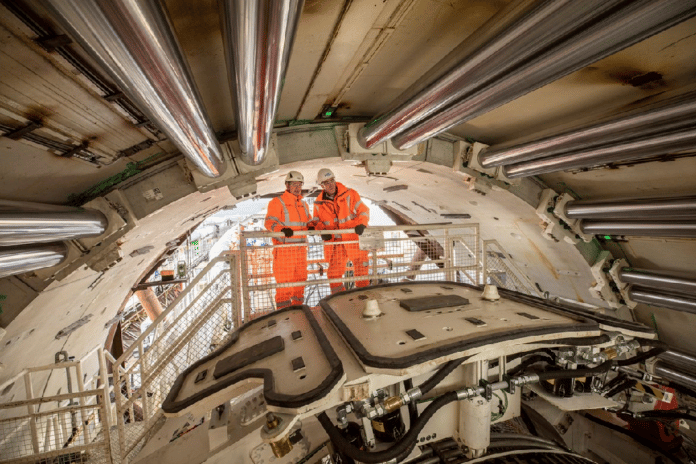HS2’s Tunnel Boring Machine Sushila may have had a couple of weeks’ head start, but Caroline, the capital’s second 2,000 tonne TBM is hot on her heels.
Launched today, Caroline has started her five-mile journey under the capital, nibbling her way from West Ruislip in West London to Greenford.
Named after 18th century astronomer Caroline Herschel, the giant machine will now dig for 22 months, non-stop except for Christmas Day, towards Greenpark way in Greenford – boring five miles of the twin-bore Northolt Tunnel. ‘Caroline’ will be operated by a crew of 15 people, working in shifts. An additional 25 people will directly support each tunnel drive on the surface.
Caroline was set off on her massive journey by HS2’s civils delivery director, Mike Lyons, who said: “HS2’s construction continues to gather pace, and the launch of the fifth Tunnel Boring Machine on HS2 is another significant moment for Britain’s number one levelling-up project.
“Creating jobs and contracts for businesses today, HS2 is an investment in Britain’s economic growth now and for generations of rail passengers to come.”
Travelling at an average of 14 metres per day, Caroline will dig the five-mile tunnel and install 4,207 tunnel segment rings to create the tunnel. Each ring of the tunnel is made up of seven concrete segments which have been manufactured in the UK by Pacadar based in Kent. She joins Sushila who has already travelled over 70 metres in the three weeks since launch.
Caroline will be operated by Skanska Costain STRABAG JV (SCS JV), HS2’s Main Works Civils Contractor constructing the HS2 tunnels in London.
James Richardson, Managing Director of Skanska Costain STRABAG JV said: “We’re delighted to have begun our tunnelling journey towards Euston, travelling under one of the busiest cities in the world. Getting to this point has been a huge team effort and the scale of this programme has enabled many new people to join the industry and work on this crucial national infrastructure project.”
Caroline’s name was chosen by pupils at Brentside Primary Academy in Ealing, who were inspired by her contribution to astronomy whilst learning about earth and space in their science lessons. German-born British astronomer Caroline Herschel was considered the first professional female astronomer, discovering three new nebulae, and was the first woman to ever discover a comet in 1786. She compiled a catalogue of 2500 nebulae and, in 1828, the Royal Astronomical Society awarded her its gold medal for this work.
Image credit: HS2 Ltd







































 0113 2082620
0113 2082620 info@railbusinessdaily.com
info@railbusinessdaily.com 15 Mariner Court, Wakefield WF4 3FL
15 Mariner Court, Wakefield WF4 3FL

